This research report provides an in-depth analysis of several key tracks of BTCFi, discussing stablecoins, lending services, staking services, restaking services, and the combination of centralized and decentralized finance (CeDeFi).
Authors: Freya, Knight, Ausdin, ZJUBCA;
Elaine, Youyu, Satoshi Lab
Abstract
As the position of Bitcoin (BTC) in the financial market continues to solidify, the BTCFi (Bitcoin Finance) field is rapidly becoming the forefront of cryptocurrency innovation. BTCFi covers a range of financial services based on Bitcoin, including lending, staking, trading, and derivatives. This research report provides a deep analysis of various key tracks of BTCFi, discussing stablecoins, lending services, staking services, restaking services, and the combination of centralized and decentralized finance (CeDeFi).
The report first introduces the scale and growth potential of the BTCFi market, emphasizing how the participation of institutional investors brings stability and maturity to the market. It then delves into the mechanisms of stablecoins, including different types of centralized and decentralized stablecoins, and their roles in the BTCFi ecosystem. In the lending field, it analyzes how users can obtain liquidity through Bitcoin lending and evaluates the major lending platforms and products.
In the staking services sector, the report focuses on key projects such as Babylon, which provide staking services for other PoS chains by leveraging the security of Bitcoin, while creating earning opportunities for Bitcoin holders. Restaking services further unlock the liquidity of staked assets, providing users with additional sources of income.
Additionally, the report explores the CeDeFi model, which combines the security of centralized finance with the flexibility of decentralized finance, providing users with a more convenient financial services experience.
Finally, by comparing the security, yield, and ecosystem richness of different asset categories, the report reveals the unique advantages and potential risks of BTCFi relative to other cryptocurrency finance fields. With the continuous development of the BTCFi field, it is expected to see more innovation and capital inflow, further consolidating Bitcoin's leadership position in the financial sector.
Keywords: BTCFi, stablecoin, lending, staking, restaking, CeDeFi, Bitcoin finance
BTCfi Track Overview:
• Squirrels collect acorns before hibernation and store them in a hidden and secure place; pirates bury looted treasures in soil known only to themselves; in today's society, people deposit cash into fixed-term accounts, seeking not only an annualized return of less than 3%, but also stability. Now imagine you have a sum of cash, you have a positive view of the cryptocurrency market but do not want to take too much risk, and you want to obtain assets with a relatively high ROI, so you choose "digital gold" BTC. You want to hold BTC for the long term, rather than making unnecessary moves based on price fluctuations. At this point, you need something to utilize your BTC, to realize its value in terms of liquidity and functionality, just like DeFi on Ethereum. It not only allows you to hold onto your assets for the long term, but also brings additional income, allowing you to reuse the liquidity of your assets, even two or three times. The variety of strategies and projects in this area is worth deep research.
• BTCFi (Bitcoin Finance) is like a mobile Bitcoin bank, a series of financial activities centered around Bitcoin, including Bitcoin lending, staking, trading, futures, and derivatives. According to data from CryptoCompare and CoinGecko, the scale of the BTCFi market has reached approximately $10 billion in 2023. According to Defilama's data, it is predicted that the BTCFi market will reach a scale of $1.2 trillion by 2030, including the total locked value (TVL) of Bitcoin in the decentralized finance (DeFi) ecosystem, as well as the market size of financial products and services related to Bitcoin. Over the past decade, the BTCFi market has shown significant growth potential, attracting more and more institutional participation. Institutions such as Grayscale, BlackRock, and JPMorgan have begun to enter the Bitcoin and BTCFi market. The participation of institutional investors not only brings in a large amount of capital, increasing market liquidity and stability, but also enhances market maturity and standardization, bringing higher recognition and trust to the BTCFi market.
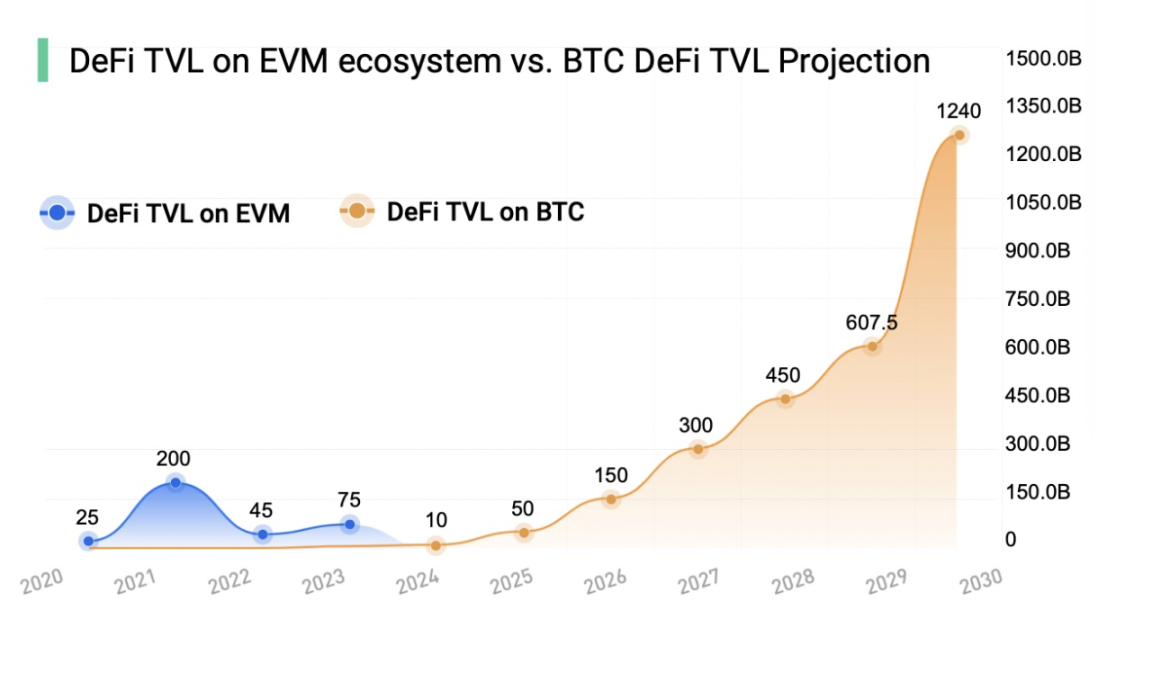
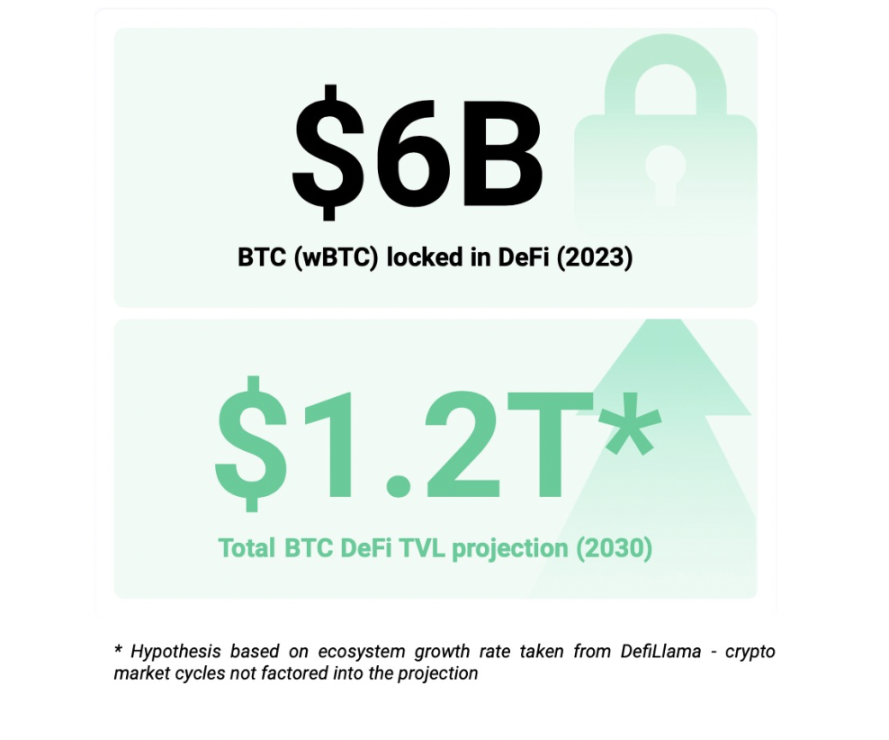
• This article will delve into several hot areas in the current cryptocurrency finance market, including Bitcoin lending (BTC Lending), stablecoins, staking services, restaking services, and the combination of centralized and decentralized finance CeDeFi (CeDeFi). Through detailed introductions and analyses of these areas, we will understand their operational mechanisms, market development, major platforms and products, risk management measures, and future development trends.
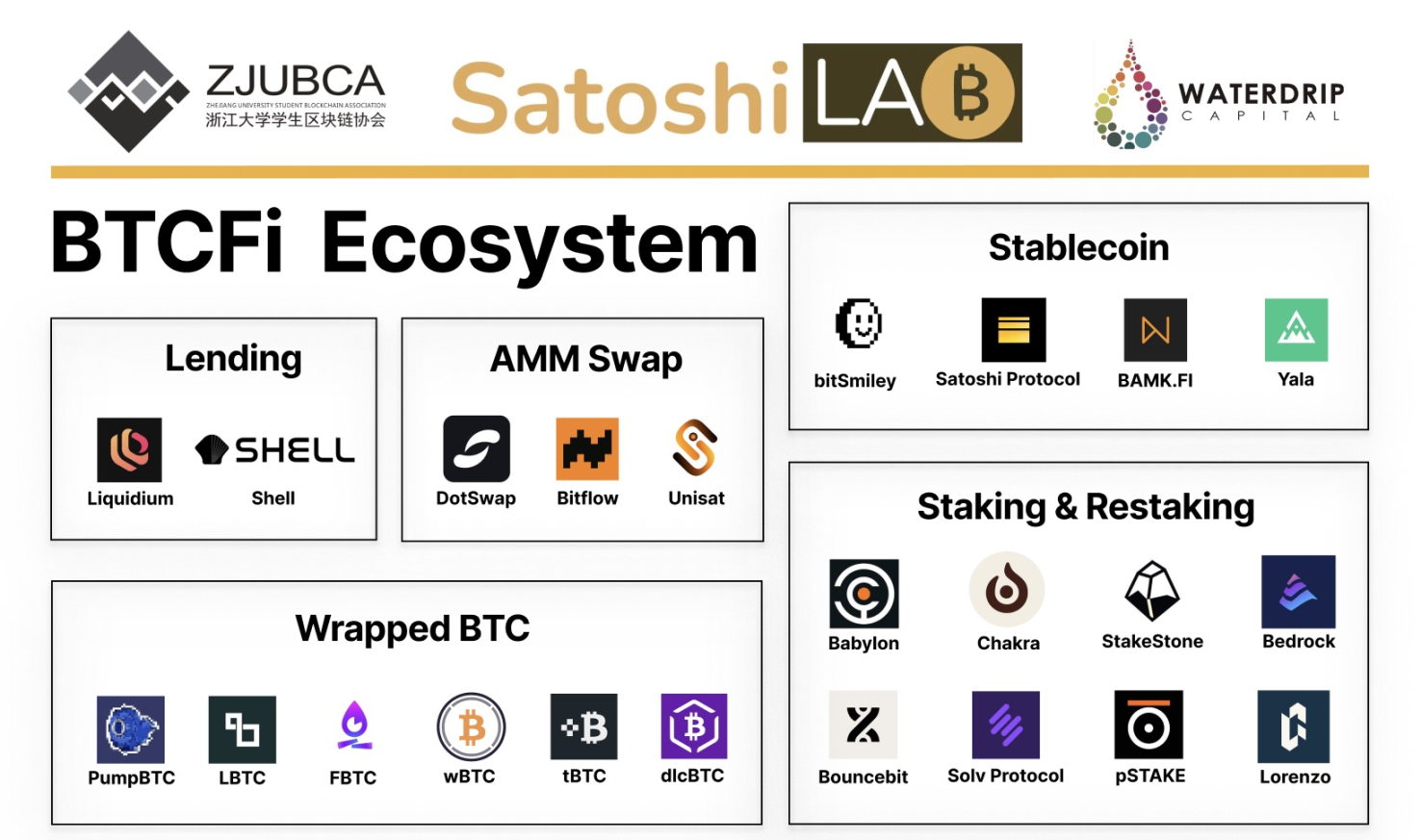
Part Two: Subdivision of BTCFi Track
1. Stablecoin Track
Introduction
• A stablecoin is a type of cryptocurrency designed to maintain a stable value. They are typically pegged to fiat currencies or other valuable assets to reduce price volatility. Stablecoins achieve price stability through asset-backed support or algorithmic supply adjustments and are widely used in trading, payments, and cross-border transfers, allowing users to enjoy the advantages of blockchain technology while avoiding the drastic fluctuations of traditional cryptocurrencies.
• In economics, there is the impossible trinity: a sovereign country cannot simultaneously achieve a fixed exchange rate system, free capital movement, and independent monetary policy. Similarly, in the context of Crypto stablecoins, there is also an impossible trinity: price stability, decentralization, and capital efficiency cannot be achieved simultaneously.
• Classifying stablecoins by their degree of centralization and collateral type are two relatively intuitive dimensions. Among the current mainstream stablecoins, they can be classified into centralized stablecoins (represented by USDT, USDC, FDUSD) and decentralized stablecoins (represented by DAI, FRAX, USDe) based on their degree of centralization. According to the type of collateral, they can be classified into fiat/physical collateral, cryptocurrency collateral, and under-collateralized stablecoins.
• According to DefiLlama data as of July 14, the total market value of stablecoins is now reported at $1,623.72 billion. In terms of market value, USDT and USDC are far ahead, with USDT leading by a wide margin, accounting for 69.23% of the total stablecoin market value. DAI, USDe, and FDUSD follow closely, ranking 3rd to 5th in market value. All other stablecoins currently account for less than 0.5% of the total market value.
• Centralized stablecoins are mostly fiat/physical collateral, essentially representing fiat/other physical assets as RWAs, such as USDT and USDC being pegged 1:1 to the US dollar, and PAXG and XAUT being pegged to the price of gold. Decentralized stablecoins are generally backed by cryptocurrency collateral or are uncollateralized (or under-collateralized). DAI and USDe are backed by cryptocurrency collateral, which can be further divided into equal collateral or over-collateralization. Unsecured (or under-collateralized) stablecoins are typically referred to as algorithmic stablecoins, with FRAX and the former UST being examples. Compared to centralized stablecoins, decentralized stablecoins have a lower market value, are designed to be slightly more complex, and have given rise to many star projects. In the BTC ecosystem, stablecoin projects worth paying attention to are decentralized stablecoins, so the mechanism of decentralized stablecoins is introduced below.
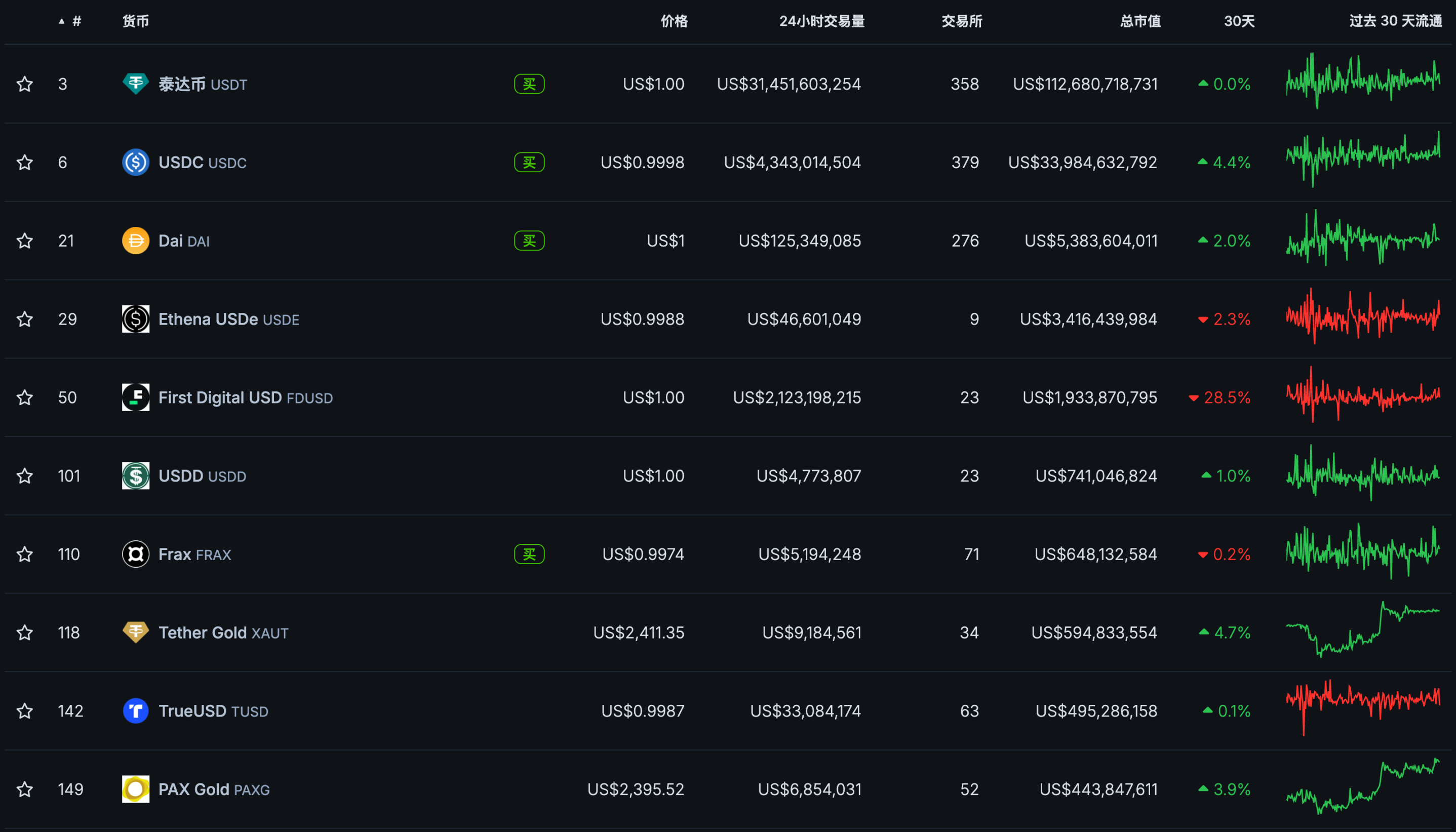
Stablecoin market value top ten as of July 14, 2024, source: Coingecko
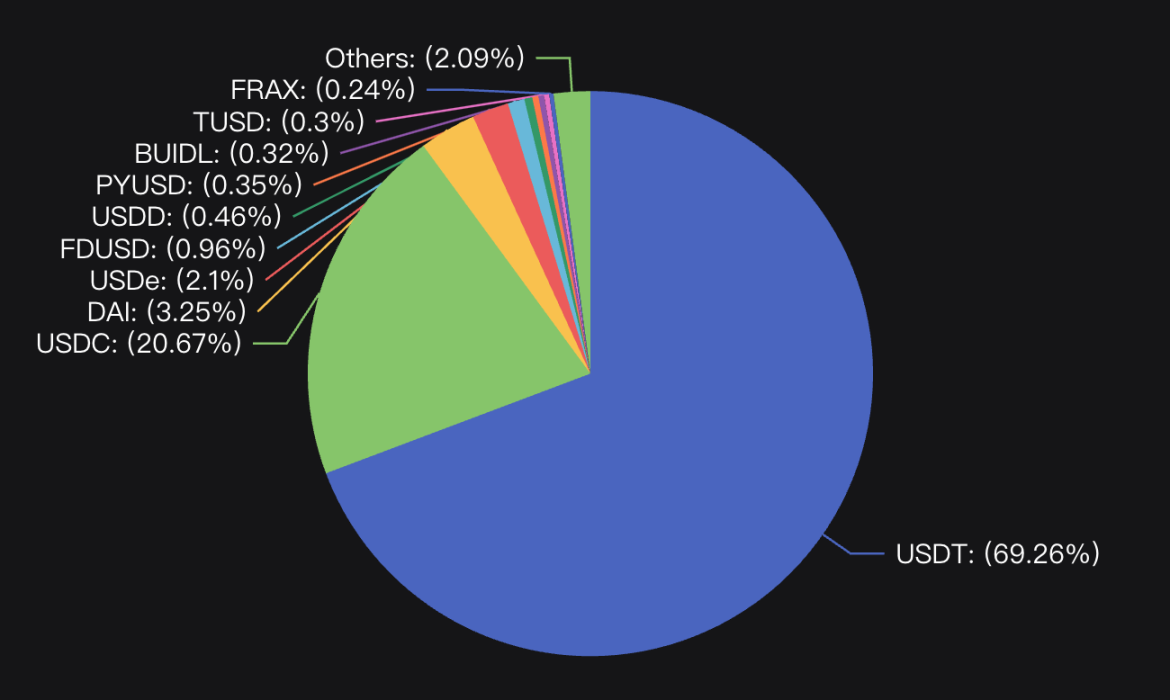
Stablecoin market value top ten percentage as of July 14, 2024, source: DefiLlama
Mechanism of Decentralized Stablecoins
• Next, the CDP mechanism represented by DAI (over-collateralization) and the contract hedging mechanism represented by Ethena (equal collateralization) will be introduced. In addition, there is also the mechanism of algorithmic stablecoins, which will not be detailed here.
• CDP (Collateralized Debt Position) represents the mechanism of generating stablecoins through collateralizing cryptocurrency assets in a decentralized financial system, pioneered by MakerDAO and now applied in many different categories of projects such as DeFi and NFTFi.
○ DAI is a decentralized, over-collateralized stablecoin created by MakerDAO, aiming to maintain a 1:1 peg to the US dollar. The operation of DAI relies on smart contracts and decentralized autonomous organizations (DAO) to maintain its stability. Its core mechanisms include over-collateralization, collateralized debt positions (CDP), liquidation mechanisms, and the role of governance token MKR.
○ CDP is a key mechanism in the MakerDAO system for managing and controlling the process of generating DAI. In MakerDAO, CDPs are now referred to as Vaults, but their core functions and mechanisms remain the same. The detailed operation process of CDP/Vault is as follows:
i. Generating DAI: Users deposit their cryptocurrency assets (such as ETH) into MakerDAO's smart contract, creating a new CDP/Vault, and then generate DAI based on the collateralized assets. The generated DAI is the portion of debt borrowed by the user, with the collateral serving as the guarantee for the debt.
ii. Over-collateralization: To prevent liquidation, users must maintain the collateralization ratio of their CDP/Vault above the system's minimum collateralization ratio (e.g., 150%). This means that if a user borrows 100 DAI, they must lock up collateral worth at least 150 DAI.
iii. Repayment/Liquidation: Users need to repay the generated DAI and a certain stability fee (calculated in MKR) to redeem their collateral. If a user fails to maintain a sufficient collateralization ratio, their collateral will be liquidated.
• Delta represents the percentage change in the price of a derivative relative to the price of the underlying asset. For example, if the Delta of an option is 0.5, when the price of the underlying asset rises by 1 USD, the option price is expected to rise by 0.5 USD. A Delta-neutral position is an investment strategy that offsets price change risks by holding a certain amount of the underlying asset and the derivative. The goal is to make the overall Delta value of the portfolio zero, thereby maintaining the value of the position when the price of the underlying asset fluctuates. For example, holding a certain amount of spot ETH and purchasing an equivalent amount of ETH short perpetual contract.
Ethena tokenizes the value of Delta-neutral positions in the form of stablecoin USDe and conducts "Delta-neutral" arbitrage trading on ETH. Therefore, their stablecoin USDe has the following two sources of income:
○ Staking income
○ Basis difference and funding rate
○ Ethena achieves equal collateralization and additional income through hedging.
Project One, Bitsmiley Protocol
Project Overview
• The first native stablecoin project in the BTC ecosystem.
• On December 14, 2023, OKX Ventures announced a strategic investment in the stablecoin protocol bitSmiley in the BTC ecosystem, which allows users to over-collateralize native BTC to mint the stablecoin bitUSD on the BTC network. Additionally, bitSmiley also includes lending and derivative protocols, aiming to provide a new financial ecosystem for Bitcoin. Previously, bitSmiley was selected as a high-quality project at the BTC hackathon jointly held by ABCDE and OKX Ventures in November 2023.
• On January 28, 2024, it was announced that the first round of token financing was completed, with OKX Ventures and ABCDE leading the investment, and participation from CMS Holdings, Satoshi Lab, Foresight Ventures, LK Venture, Silvermine Capital, and individuals from Delphi Digital and Particle Network. On February 2, LK Venture under Blueport Interactive, a Hong Kong-listed company, announced its participation in the first round of financing for bitSmiley through the BTC NEXT Bitcoin network ecosystem investment management fund. On March 4, KuCoin Ventures announced a strategic investment in the Bitcoin DeFi ecosystem project bitSmiley.
Operation Mechanism
• bitSmiley is a Bitcoin-native stablecoin project based on the Fintegra framework. It consists of the decentralized over-collateralized stablecoin bitUSD and the native trustless lending protocol (bitLending). bitUSD is based on bitRC-20, a modified version of BRC-20, and is also compatible with BRC-20. bitUSD has added operations for minting and burning to meet the needs of stablecoin minting and burning.
• In January, a new DeFi inscription protocol called bitRC-20 was launched by bitSmiley. The first asset of this protocol, OG PASS NFT, also known as bitDisc, is divided into two levels: gold card and black card. The gold card is allocated to Bitcoin OG and industry leaders, with fewer than 40 holders. Starting from February 4, the black card will be open to the public in the form of an inscription through whitelist activities and public minting activities using BRC-20, causing congestion on the chain. Subsequently, the project team stated that compensation would be provided for unsuccessful inscriptions.
• Operation Mechanism of $bitUSD Stablecoin
The operation mechanism of $bitUSD is similar to $DAI. Users first over-collateralize, and then the bitSmileyDAO on L2, after receiving oracle information and achieving consensus verification, sends out the information to mint bitRC-20 on the BTC mainnet.
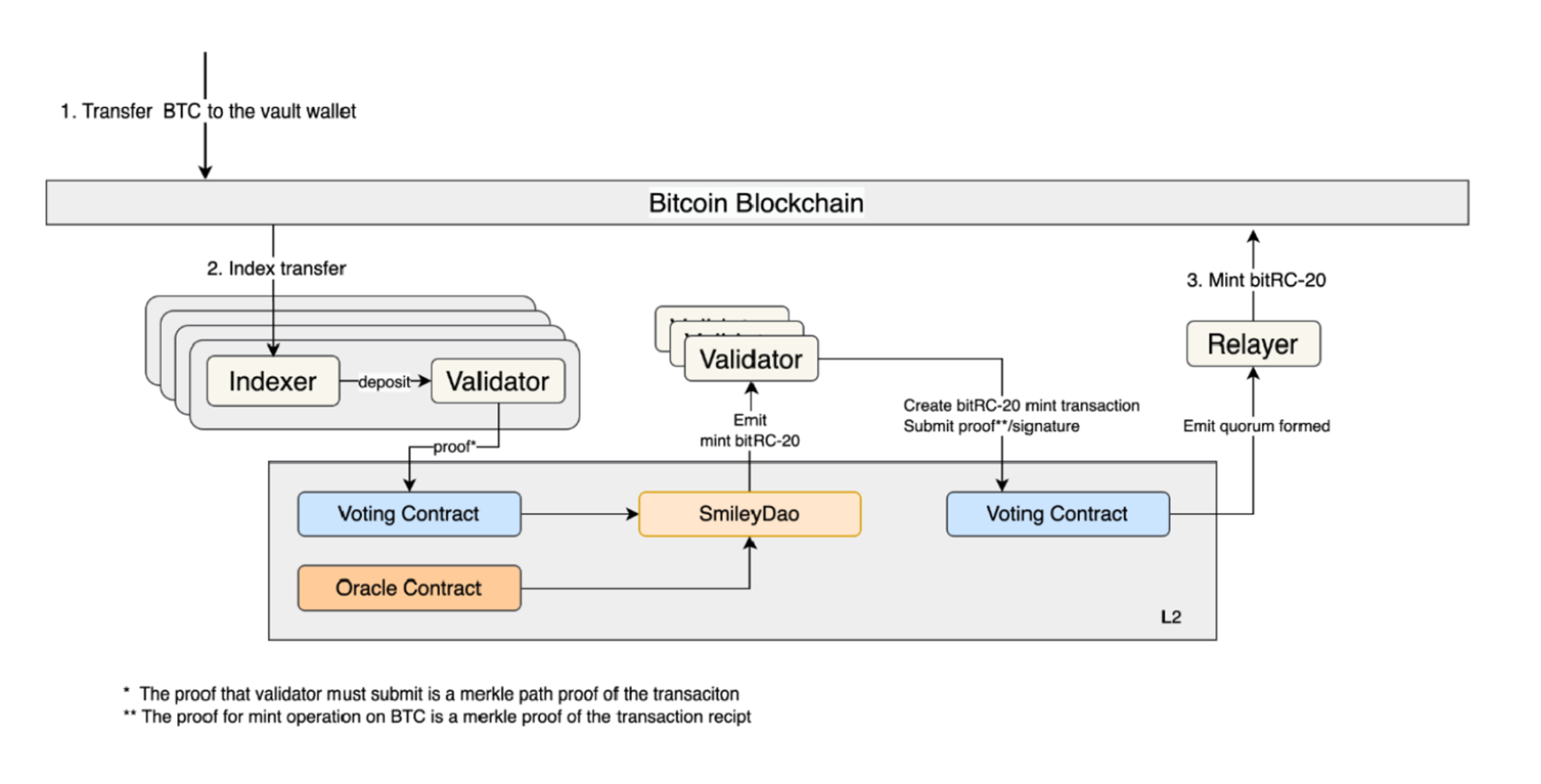
Source: https://github.com/bitSmiley-protocol/whitepaper/blob/main/BitSmiley_White_Paper.pdf
• The logic of liquidation and redemption is similar to MakerDAO, and liquidation adopts a Dutch auction format.
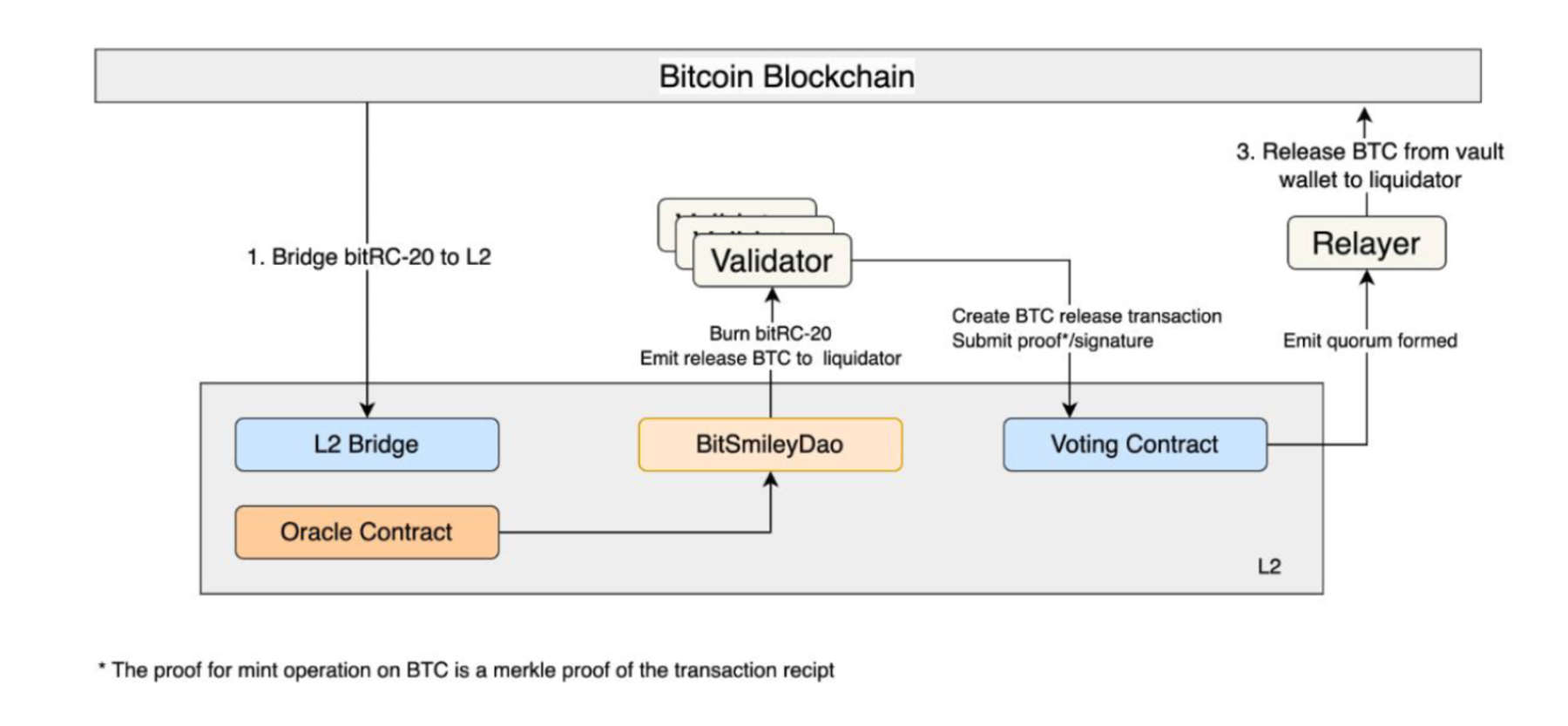
Source: https://github.com/bitSmiley-protocol/whitepaper/blob/main/BitSmiley_White_Paper.pdf
Project Progress & Participation Opportunities
• bitSmiley was launched on Alphanet on BitLayer on May 1, 2024. The maximum loan-to-value ratio (LTV) is 50% to prevent users from being liquidated, a relatively low LTV ratio is set. As the adoption of bitUSD increases, the project will gradually increase the LTV.
• bitSmiley and the Merlin community will launch an exclusive liquidity incentive grant from May 15, 2024, to increase the liquidity of bitUSD. The detailed rules are as follows:
○ bitSmiley will provide up to 3,150,000 $BIT tokens as rewards to Merlin community members. Rewards will be unlocked based on user behavior in the Merlin community. Season 1 duration: May 15, 2024, to August 15, 2024.
○ Rewards: Incentives for minting bitUSD and adding liquidity to the bitUSD pool on bitCow. Liquidity incentives will be distributed based on the bitPoints obtained by users on the Merlin chain. The more points a user obtains, the more token incentives they will receive.


Source: https://medium.com/@bitsmiley/exclusive-liquidity-incentive-grant-details-bitsmiley-x-bitcow-alpha-net-on-merlin-chain-3f88c4ddb32d
Project Two, Bamk.fi (NUSD)
Project Overview
• Bamk.fi protocol is the issuer of NUSD (Nakamoto Dollar), a synthetic dollar on the Bitcoin L1. NUSD circulates on BRC 20-5 byte and Runes protocols (currently both are equivalent).
Operation Mechanism
• The project is designed in two phases. In the first phase, NUSD is backed by USDe at a 1:1 ratio, and holding NUSD can accumulate BAMK in each block (the earlier one holds NUSD, the more BAMK can be obtained). In the second phase, NUSD will be fully supported by delta-neutral Bitcoin positions and will receive native income, i.e., "Bitcoin bonds," while also enabling minting and redemption based on BTC. However, the current minting method provided on the official website is 1:1 minting by USDT.
• The project token BAMK mentioned above is in rune form, with the rune code BAMK•OF•NAKAMOTO•DOLLAR, minted on April 21, 2024, with a maximum supply of 21,000,000,000 (21 billion). 6.25% of the supply has been provided as rewards to all NUSD holders. Simply purchasing NUSD and holding it in a wallet will start accumulating BAMK tokens. Every block between 844,492 and 886,454 - a total of 41,972 blocks will accumulate 31,250 BAMK, distributed proportionally based on the user's NUSD holdings divided by the total NUSD TVL of that block height.
Project Three, Yala Labs
Project Overview
• Yala enables its stablecoin $YU to flow freely and securely between various ecosystems through its self-built modular infrastructure, unlocking BTC liquidity and bringing significant capital vitality to the entire crypto ecosystem.
• Core products include:
○ Over-collateralized stablecoin $YU: This stablecoin is generated through over-collateralizing Bitcoin and the infrastructure is not only based on the native Bitcoin protocol but can also be deployed freely and securely in the EVM and other ecosystems.
○ Metamint: A core component of $YU, allowing users to easily mint $YU using native Bitcoin in various ecosystems, injecting Bitcoin liquidity into these ecosystems.
○ Insurance derivatives: Providing comprehensive insurance solutions within the DeFi ecosystem, creating arbitrage opportunities for users.
Operation Mechanism
• To facilitate the use of $YU in various ecosystems, the Metamint solution has been introduced. Users can easily mint $YU on any target chain, whether using native Bitcoin or wrapped BTC on the EVM, by simply collateralizing BTC. To lower the entry barrier, users do not need to manually wrap Bitcoin; they only need to collateralize BTC, and the system will automatically generate the required wrapped BTC on the backend to mint $YU on the target chain.
• Through this seamless asset conversion solution, users can participate in various DeFi protocols across ecosystems, including cross-chain yield farming, staking, and other DeFi activities, opening up new revenue opportunities. This multi-chain solution significantly enhances the potential for users to earn greater returns. Unlike traditional stablecoin companies that concentrate profits, Yala returns the fees generated by the system to core $YU holders, ensuring that users directly benefit from the growth of the ecosystem.
• Features and Advantages
○ Using Bitcoin as the primary collateral while also enjoying the security and resilience of the Bitcoin network.
○ Users can earn returns by participating in various DeFi activities using $YU.
○ Yala follows a user-centric decentralized governance structure, and income is also returned to core users.
Project Progress & Participation Opportunities:
Through collaborations with outstanding projects, Yala provides users with various revenue opportunities while ensuring security. For example, through collaboration with Babylon, Yala users can over-collateralize BTC on the platform and mint the stablecoin $YU, then further pledge these collaterals to the Babylon platform to achieve multiple returns. As the Babylon staking protocol does not require third-party custody, this integration not only enhances returns but also ensures the absolute security of user assets.
Yala's roadmap focuses on building a robust liquidity layer, connecting Bitcoin to prominent Layer 1 and Layer 2 ecosystems in the market. To ensure security and the best user experience, Yala will gradually launch its mainnet and testnet in phases:
• Testnet V 0: $YU stablecoin issuance, Pro mode, oracles, and prophecy machines.
• Testnet V1: Lightweight mode of $YU stablecoin with yield.
• V1 release: Insurance module and security upgrades.
• V2 launch: Governance framework activation.
As the testnet launch approaches, Yala has received support from first-line funds. Please stay tuned for recent financing news announcements for specific institutions and valuation.
Project Four, Satoshi Protocol
Project Overview
• The first CDP stablecoin protocol in the BTC ecosystem, based on the BEVM ecosystem.
• Satoshi Protocol announced the completion of its seed round financing on March 26, 2024, with Web3Port Foundation and Waterdrip Capital leading the round, and participation from BEVM Foundation, Cogitent Venture, and Statoshi Lab, among others. On July 9, 2024, it announced the completion of a $2 million financing.
Operation Mechanism
• By offering low interest rates, Satoshi Protocol allows Bitcoin holders to release liquidity from their assets. Additionally, Satoshi Protocol is a multi-chain protocol, and its stablecoin SAT has a highly compatible multi-token standard mechanism. Satoshi Protocol currently has two tokens: the stablecoin SAT pegged to the US dollar and the utility token OSHI, which incentivizes and rewards ecosystem participants. Users can mint the dollar-pegged stablecoin $SAT by depositing BTC and LST, among other BTC-based interest-bearing assets, at a minimum collateralization ratio of 110%, and participate in trading, liquidity pools, lending, and other scenarios to earn profits.
• In the Satoshi Protocol, users must maintain a collateralization ratio of at least 110% when opening a position to avoid liquidation. For example, when borrowing 100 SAT, the user must lock in BTC with a total value higher than 110 SAT as collateral. If the price of BTC falls, causing the collateral value to drop below the 110% collateralization ratio, the protocol will initiate the liquidation mechanism.
• The stable pool is the core mechanism of the Satoshi Protocol, designed to settle the debt of under-collateralized positions (collateralization ratio below 110%) by providing liquidity, ensuring the stability of the system. When under-collateralized positions are liquidated, SP uses SAT to settle the debt and obtains the liquidated BTC collateral. Users participating in the stable pool can purchase these liquidated BTC collateral at a discount, and the protocol uses the SAT obtained from the liquidation to repay the debt.
Project Progress & Participation Opportunities
• In the latest announcement, Satoshi Protocol is developing a Runes stablecoin based on the Bitcoin mainnet. Additionally, through collaborations with projects like Omini Network, it aims to bridge the Bitcoin and Ethereum ecosystems to achieve the vision of "full-chain stablecoins."
• Currently, there is an airdrop points activity for $OSHI, where users can earn points by voting for the project in the BVB plan, depositing collateral to borrow $SAT, providing liquidity, and recommending, and later receive $OSHI based on the points earned.
Project Five, BTU
Project Overview
• BTU is the first decentralized stablecoin project in the Bitcoin ecosystem, using a collateralized debt position (CDP) model that allows users to issue stablecoins based on BTC assets. BTU solves the liquidity problem for Bitcoin holders in the existing decentralized finance (DeFi) ecosystem through seamless decentralized design, providing a safer, trustless stablecoin solution.
Operation Mechanism
Bitcoin-backed stablecoin: BTU is a fully decentralized stablecoin collateralized by Bitcoin. Users can directly mint stablecoins by locking BTC in the BTU protocol, without transferring assets off-chain or relinquishing control of BTC. This design ensures decentralization and avoids the risks associated with traditional centralized exchanges or custodians.
No need for cross-chain bridges: Unlike other solutions that rely on cross-chain bridges, BTU completes all operations within the Bitcoin network, eliminating the need for users to transfer BTC across chains. This design eliminates third-party risks associated with cross-chain processes, further enhancing the security and control of user assets.
Asset proof without trading: BTU introduces a mechanism to prove BTC holdings without the need for trading, allowing users to prove their assets without transferring their Bitcoin. This trustless, seamless design provides users with additional flexibility, allowing them to participate in the DeFi ecosystem while retaining full control of their BTC assets.
Decentralized CDP model: BTU adopts a decentralized collateralized debt position (CDP) model, allowing users to autonomously control when to issue or redeem BTU stablecoins. The protocol design ensures that users' BTC can only be used with their consent, maintaining a high level of decentralization and control.
Increased liquidity and leverage: BTU is the first protocol to map BTC on the Bitcoin network and increase its liquidity and leverage. Through this mechanism, BTC holders can bring their assets into the DeFi ecosystem without sacrificing decentralization, enjoying greater flexibility and investment opportunities.
• By unlocking Bitcoin liquidity, BTU provides a trustless, decentralized way for BTC holders to participate in the DeFi ecosystem. Traditionally, Bitcoin holders have struggled to participate in DeFi and on-chain financial activities without relying on centralized exchanges or custodians. The emergence of BTU presents new opportunities for Bitcoin holders, allowing them to safely issue stablecoins, increase liquidity, and retain control of their BTC.
• This innovative decentralized stablecoin solution not only provides more financial options for BTC holders but also brings new growth potential to the DeFi ecosystem. By driving the release of Bitcoin liquidity, BTU has the potential to drive the emergence of a new generation of DeFi applications and protocols, further expanding the user base and use cases of the DeFi market.
• BTU's infrastructure design emphasizes decentralization and security. As it operates entirely within the Bitcoin network, BTU does not require the introduction of cross-chain bridges or third-party custody, significantly reducing issues related to centralized risks. BTU's decentralized model ensures seamless integration with the existing Bitcoin ecosystem without introducing additional technical or security risks.
Project Progress & Participation Opportunities
• The project has received investment support from Waterdrip Capital, Founder Fund, and Radiance Ventures.
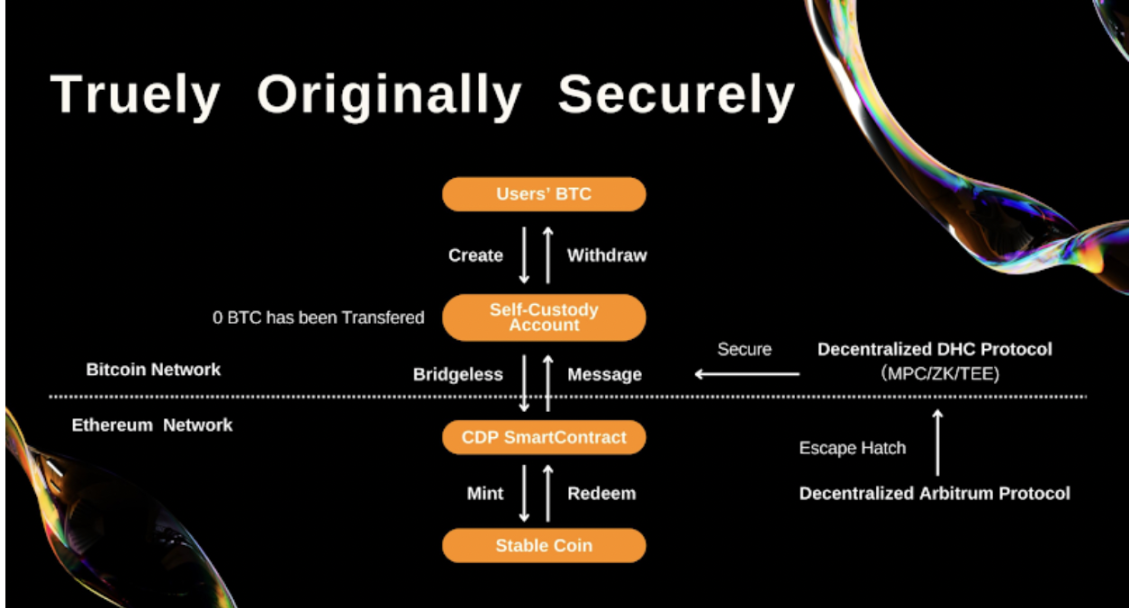
2. Lending Track
Introduction
• Bitcoin lending (BTC Lending) is a financial service that allows users to obtain loans by using Bitcoin as collateral or earn interest by lending Bitcoin. Borrowers deposit Bitcoin into lending platforms, and the platform provides loans based on the value of Bitcoin, with borrowers paying interest and lenders earning returns. This model provides liquidity for Bitcoin holders and offers new revenue channels for investors.
• Collateralized loans in BTC Lending are similar to traditional home mortgage loans in traditional finance. If a borrower defaults, the platform can auction the collateralized Bitcoin to recover the loan. BTC Lending platforms typically implement the following risk management measures:
Control of collateralization ratio and loan-to-value ratio (LTV): The platform sets an LTV. For example, if the value of Bitcoin is $10,000, the loan amount does not exceed $5,000 (LTV is 50%). This provides a buffer for Bitcoin price fluctuations.
Additional collateral and margin calls: When the price of Bitcoin falls, borrowers need to add collateral to reduce the LTV. If they fail to do so, the platform may force liquidation.
Forced liquidation mechanism: When borrowers fail to add margin, the platform sells part or all of the collateralized Bitcoin to repay the loan.
Risk management and insurance: Some platforms establish insurance funds or collaborate with insurance companies to provide additional protection.
• From 2013 to 2017, Bitcoin gradually gained acceptance as a new asset class, and early lending platforms such as Bitbond and BTCJam emerged, mainly operating through a P2P model. From 2018 to 2019, the cryptocurrency market grew rapidly, with more platforms like BlockFi, Celsius Network, and Nexo emerging, driven by the DeFi concept, leading to the rise of decentralized lending platforms.
• Since 2020, the global financial markets have been in turmoil due to the COVID-19 pandemic, and cryptocurrencies have gained attention as a safe-haven asset. The demand for BTC Lending has increased significantly, leading to a rapid expansion of lending volumes. Major platforms continue to innovate, introducing various financial products and services such as flash loans, liquidity mining, and cryptocurrency reward credit cards, attracting more users.
• The BTC Lending track has become an important part of the cryptocurrency market, covering major cryptocurrencies such as Bitcoin and Ethereum. Lending products include collateralized loans, deposit accounts, and unsecured loans. Platforms profit from spreads and fees. Popular platforms like Aave offer flash loans and liquidity mining rewards, MakerDAO provides the DAI Savings Rate (DSR), and Yala offers DeFi yields based on stablecoins. The following will introduce popular products in the BTC Lending track.
Project One, Liquidium
Project Overview
• Liquidium is a P2P lending protocol running on Bitcoin, supporting users to borrow and lend native Bitcoin using collateralized Ordinals and Runes assets.
• On December 11, 2023, Liquidium completed a $1.25 million Pre-Seed round of financing, with participation from Bitcoin Frontier Fund, Side Door Ventures, Actai Ventures, Sora Ventures, Spicy Capital, UTXO Management, among others.
• On July 18, 2024, it completed a $2.75 million seed round of financing. This round was led by Wise 3 Ventures, with participation from Portal Ventures, Asymmetric Capital, AGE Fund, Newman Capital, among others.
Operation Mechanism
• The platform completes Bitcoin lending in a secure and non-custodial manner through Partially Signed Bitcoin Transactions (PSBT) and Discreet Log Contracts (DLC) on the Bitcoin L1. It currently supports lending of Ordinals and Runes assets (BRC-20 is in testing).
• Tokenomics: The LIQUIDIUM•TOKEN in Rune form was launched on July 22, 2024, with a total supply of 100M. The genesis airdrop has been completed. As of September 3, the LIQUIDIUM•TOKEN has a market price of approximately $0.168, with a market cap of $2M.
• According to Geniidata, as of September 3, the protocol's total trading volume has reached approximately 2400 BTC, with the majority being Ordinals and a small portion being Runes assets. The protocol's trading volume peaked in April-May, with an average daily trading volume of approximately 15-20 BTC of Ordinal assets. With the launch of Runes, DAU and trading volume reached a new peak and then gradually declined. The trading volume in August and September decreased to an average of 5-10 BTC per day.
Project Two, Shell Finance
Project Overview
• Shell Finance is a stablecoin protocol based on BTC L1, supporting the use of BTC, Ordinals NFT, Runes, BRC-20, and ARC-20 assets as collateral to obtain $bitUSD.
Operation Mechanism
• Similar to Liquidium, it uses PSBT and DLC technology to achieve native Bitcoin lending. PSBT allows secure and collaborative transaction signing, while DLC allows conditional and trustless contract execution based on verified external data.
• Unlike Liquidium's P2P model, Shell Finance adopts a peer-to-pool approach to maximize utilization.
• The Testnet has not been launched yet.
3. Staking Track
Introduction
• Staking is typically known for its secure and stable income characteristics. When users "stake" tokens, they usually receive some form of access rights, privileges, or reward tokens over time in exchange for locking their tokens, which can be withdrawn at any time. Staking occurs at the network level and is used solely to secure the network. Ethereum's Proof of Stake (PoS) mechanism is the most typical example of staking, with over 565,000 validators holding the standard 32 ETH, which is worth over $32 billion today. Staked assets are often linked to DeFi liquidity, yield rewards, and governance rights. Locking tokens in a blockchain network or protocol to receive rewards, these tokens are used to provide critical services to users.
• The concept of shared security brought by Staking in the current modular track provides a new dimension, leveraging the potential of "digital gold and silver." From a narrative perspective, it not only releases trillions of market value in liquidity but is also a key core of future scalability. For example, the recent Bitcoin staking protocol Babylon and the Ethereum re-staking protocol EigenLayer each secured massive financing of $70 million and $100 million, respectively, indicating strong recognition from top VCs for this track.
• At present, this track is mainly divided into two factions: 1. Layer 1 with sufficient security as the functional layer of Rollups; 2. Rebuilding an entity with security close to Bitcoin/Ethereum and better performance, such as the well-known Celestia, which aims to create a secure, decentralized, and high-performance DA layer through a pure DA functional architecture and low gas costs in a short time. The disadvantage of this approach is that it still needs time to achieve full decentralization and lacks orthodoxy. In contrast, newly emerged projects like Babylon and Eigenlayer are more neutral compared to the former two, inheriting orthodoxy and security while giving main chain assets more utility value—by using PoS, they leverage the value of Bitcoin or Ethereum assets to create shared security services.
Project One, Babylon
Project Overview
• Babylon is a layer 1 blockchain founded by Stanford University professor David Tse. The project's mission is to bring unparalleled security to all PoS blockchains without any additional energy costs. The team consists of researchers and experienced developers from Stanford University, as well as experienced business advisors.
• Babylon is a Bitcoin staking protocol, with its core component being a POS public chain compatible with Cosmos IBC, which can lock Bitcoin on the Bitcoin mainnet to provide security for other POS consumer chains, while earning staking rewards on the Babylon mainnet or POS consumer chains. Babylon allows Bitcoin to leverage its unique security and decentralization to provide economic security for other POS chains, enabling rapid launches of other projects.
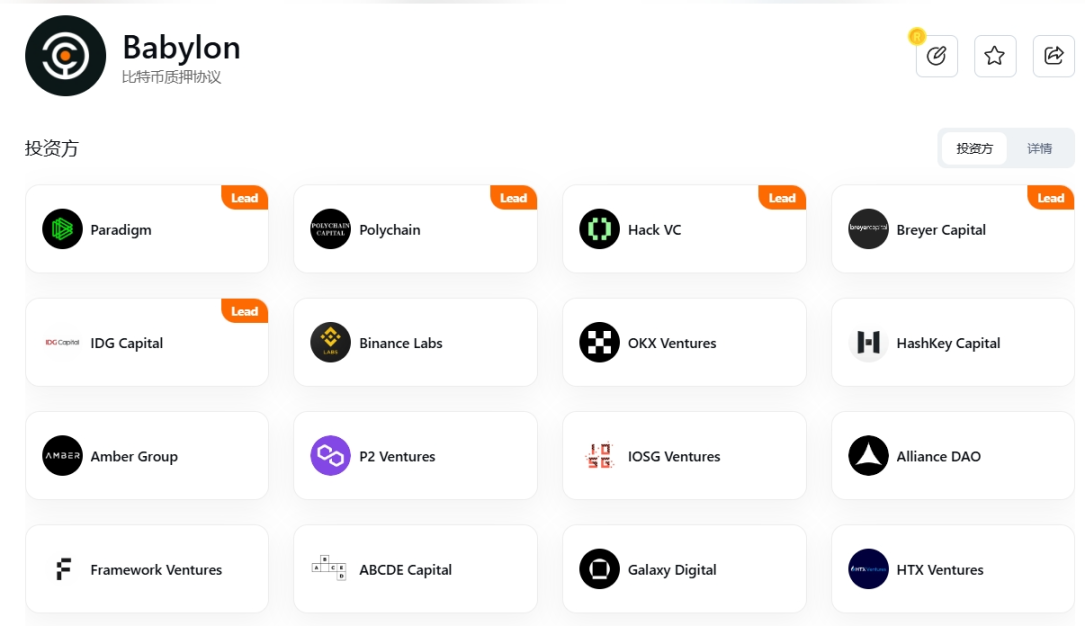
Source: https://www.rootdata.com/zh/Projects/detail/Babylon?k=MjgwNQ%3D%3D
• Babylon's team consists of 32 technical personnel and advisors. The team's technical strength is strong, and the team's advisors include Sunny Aggarwal, co-founder of Osmosis lab, and Sreeram Kannan, founder of Eigenlayer, serving as strategic advisors. As of June 1, 2024, Babylon has disclosed multiple rounds of financing, totaling over $96.8 million. The table below shows that compared to other Bitcoin Layer 2 projects, Babylon has a higher financing amount and numerous institutional investors.

Operation Mechanism
• In terms of operation mechanism, Babylon is consistent with Ethereum's re-staking protocol EigenLayer. "Bitcoin + Babylon" can be seen as "Ethereum + EigenLayer". However, since Bitcoin does not support smart contracts, Babylon needs to take an additional step compared to EigenLayer, which is the most difficult step, to make un-stakable Bitcoin stakable first, and then proceed with Bitcoin re-staking.
• Babylon uses UTXO to implement staking contracts, known as Remote Staking. That is, BTC security is transmitted to PoS chains through an intermediate layer, while cleverly combining existing opcodes in terms of thinking. The specific steps of contract implementation can be broken down into the following four steps:
a. Locking funds Users send funds to an address controlled by multi-signature. Through OPCTV (OPCHECKTEMPLATEVERIFY, allowing the creation of predefined transaction templates to ensure that transactions can only be executed according to specific structures and conditions), the contract can specify that the funds can only be spent under specific conditions. After the funds are locked, a new UTXO is generated to represent the staked funds.
b. Condition verification Calling OPCSV (OPCHECKSEQUENCEVERIFY, allowing the setting of a relative time lock based on the transaction's sequence number, indicating that the UTXO cannot be spent until a certain time or number of blocks has passed) can implement a time lock to ensure that the funds cannot be withdrawn within a certain period. Combined with the aforementioned OP_CTV, staking, unstaking (when the staking time is met, the staker can spend the locked UTXO), and slashing (if the staker behaves maliciously, the UTXO will be forcibly spent to a locked address and restricted from being spent, similar to a black hole address) can be achieved.
c. State update Whenever a user stakes or unstakes funds, it involves the creation and spending of UTXOs. New transaction outputs will generate new UTXOs, while old UTXOs will be marked as spent. This way, every transaction and fund movement is accurately recorded on the blockchain, ensuring transparency and security.
d. Reward distribution Based on the staked amount and staking time, the contract will calculate the rewards due and distribute them by generating new UTXOs. These rewards can be unlocked and spent after meeting specific conditions through script conditions.
• Babylon's overall architecture can be divided into three layers: Bitcoin (as a timestamp server), Babylon (a Cosmos Zone) as the intermediate layer, and the PoS chain demand layer. Babylon refers to the latter two as the Control Plane (Babylon itself) and the Data Plane (various PoS consumer chains).
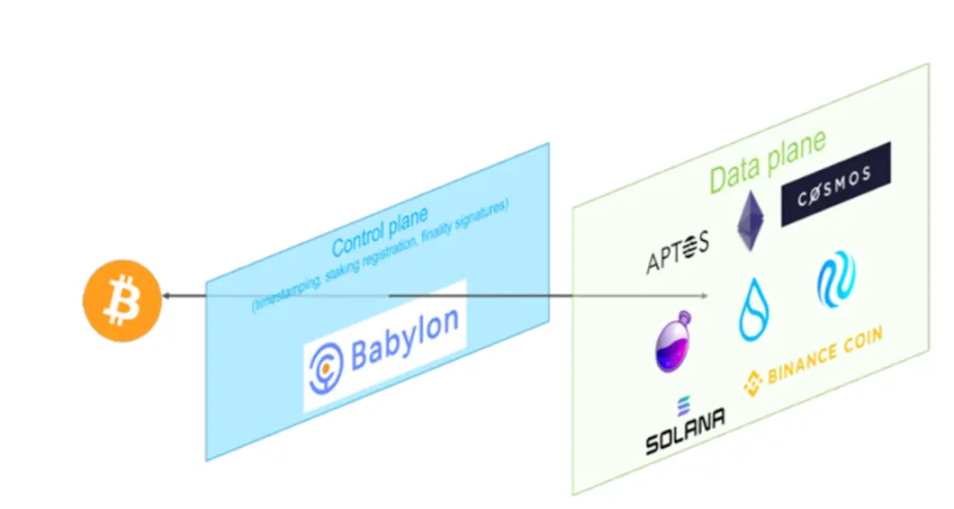
• Validators of various PoS chains download Babylon blocks and observe whether their PoS checkpoints are included in the Bitcoin-checked Babylon blocks. This allows PoS chains to detect discrepancies, such as if Babylon validators create an invalid block checked by Bitcoin and lie about the PoS checkpoints included in the invalid block.
• Therefore, there are penalty rules. If a validator fails to withdraw their stake when detecting an attack, they can be penalized for producing PoS blocks with conflicting double signatures. Malicious PoS validators may fork the PoS chain when allocating Bitcoin timestamps to PoS blocks. This will change the top chain of the PoS chain to the bottom chain in later PoS clients. Although this is a successful security attack, it will result in the penalty of the stake of malicious PoS validators because they have conflicting double signature blocks but have not withdrawn their staked assets.
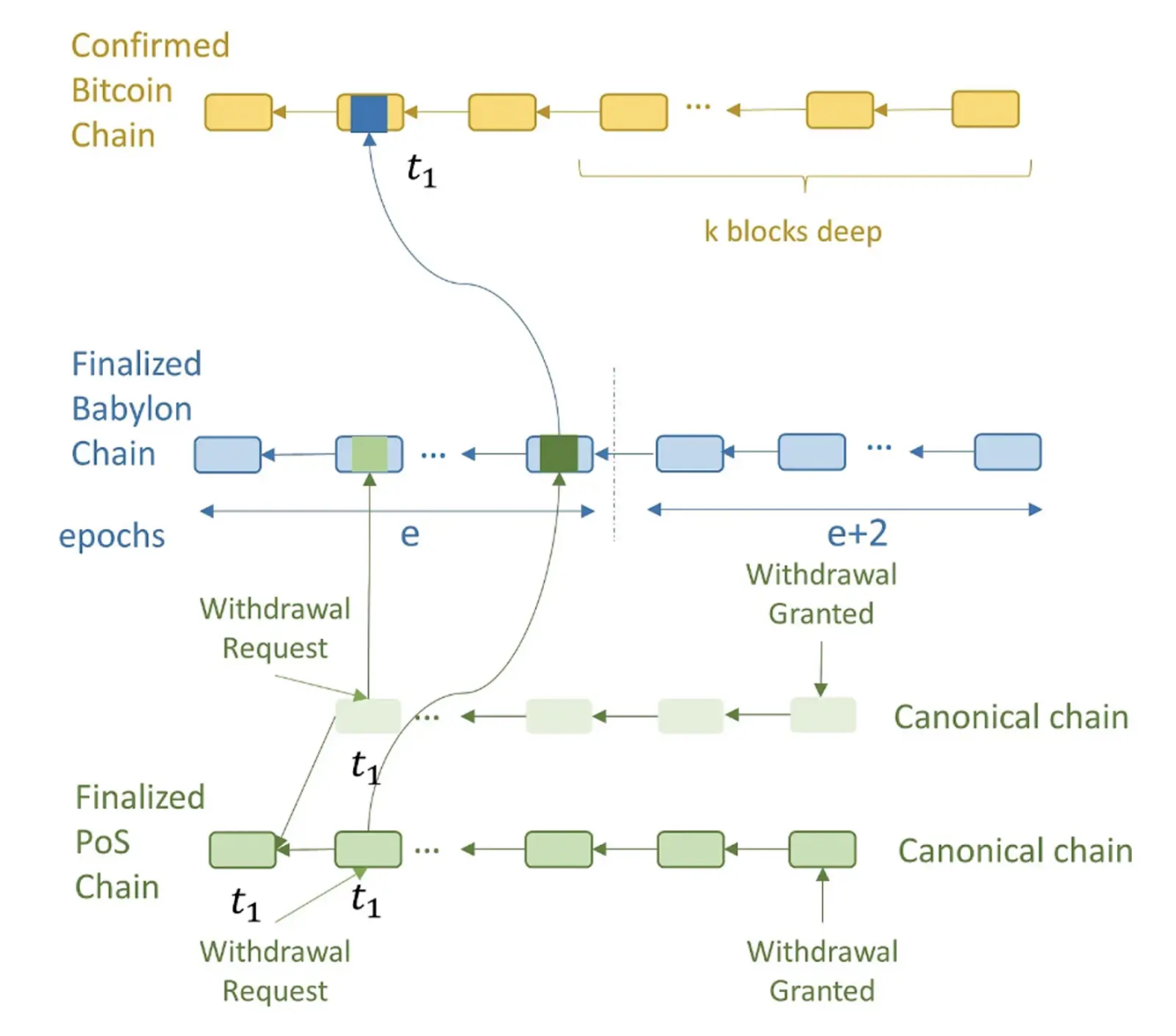
Project Progress & Participation Opportunities
• In February 2023, Babylon achieved the BTC timestamping testnet. In July, it achieved the BTC staking POC, and the BTC staking testnet will be launched in Q4.
• In Q2 of 2024, Babylon will launch the Mainnet, and in Q3-Q4 of 2024, Data Availability, currently in testnet 4, will be launched. Users participating in the testnet will receive some project points as incentives, which can be exchanged for governance token airdrops on the mainnet.
• The mainnet is expected to be launched soon. On August 1, 2024, Babylon began the pre-staking process with popular re-staking projects such as chakra, bedrock, solv protocol, and pstake. Users can already participate in Babylon's pre-staking through the aforementioned projects and receive corresponding shares. This is a very good time to participate. After the mainnet is launched, stakers on the mainnet will also receive governance tokens, and stakers can receive the staking network's annualized returns at any time.
4. Restaking Track
Introduction
• Building on staking, ETH introduced the concept of restaking for the first time. ReStaking involves using staked token assets for liquidity to stake validators on other networks and blockchains to earn additional returns, while still contributing to the security and decentralization of the new network. Through ReStaking, investors can receive double returns from both the original network and the ReStaking network. While ReStaking allows stakers to earn greater returns, it also carries risks of smart contract vulnerabilities and fraudulent staking behavior by validators.
• In addition to accepting original assets, the ReStaking network also accepts other assets such as LSD tokens, LP tokens, etc., which increases the network's security. While still generating actual income for the protocol and its users, it releases unlimited liquidity sources in the DeFi market. The income of the ReStaking network and the standard network comes from security leasing, validators, dApps, protocol and layer fees generated. Staking participants on the network will receive a portion of the network's income and may also receive inflation rewards in the network's native tokens.
• Many BTC holders will stake their BTC in projects like Babylon and Bedrock to earn substantial annualized returns and governance tokens. Early participants can receive significant profits and long-term returns. However, their BTC will lose other utility value due to staking. So, how can new liquidity be unlocked to give their BTC more value? Since it's not possible to release more liquidity for BTC, the focus shifts to LSD, releasing the liquidity of LSD obtained through staking. Users are eager to use the staked BTC assets to restake and gain fivefold returns—annualized staking returns, governance tokens from staking, annualized restaking returns, and governance tokens from restaking.
Project One: Chakra
Project Overview
• Chakra is an innovative modular settlement infrastructure that uses zero-knowledge proof technology to ensure trustless security and efficiency. By integrating decentralized Bitcoin liquidity, Chakra provides a more secure and seamless settlement experience. Users can easily stake Bitcoin and participate in more liquidity opportunities, including LST/LRT projects within the Babylon ecosystem, using Chakra's advanced settlement network.
• Chakra is strongly supported by the Starknet ecosystem. In March 2024, it was announced that Chakra had received investments from StarkWare, CoinSummer, and early investments from several billionaires and miners.
Operation Mechanism
• Chakra provides highly modular Bitcoin settlement networks to enable free movement of BTC derivative assets between major public chains, injecting liquidity into DeFi protocols and solving liquidity and interoperability issues for Bitcoin in the current blockchain ecosystem. Chakra enhances economic security using finality provided by the Babylon network, preventing settlement errors due to consensus attacks. The Chakra team has designed and implemented a parallel virtual machine (Parallel VM) that achieves over 5000 TPS with 4 threads and can reach up to 100,000 TPS in a high-configured environment with 64 threads.
Project Progress
• Chakra launched Devnet in May to incentivize developers to build the application ecosystem. It has established strong connections with several local communities of Starknet and will launch a series of developer education activities and Devnet incentives with Starknet's support. In June, during the testnet launch activity alongside Babylon, Chakra became the top Finality Provider for the entire Babylon network, contributing 41% of the network's staked users.
Project Two: Bedrock
Project Overview
• Bedrock is a multi-asset liquidity restaking protocol supported by a non-custodial solution designed in collaboration with RockX. Bedrock maximizes the liquidity and value of PoS tokens (such as ETH and IOTX) and existing liquidity staked tokens (uniETH and uniIOTX).
• Bedrock provides institutional-grade services and had a total value locked (TVL) of over $200 million as of May 2, becoming the first to build liquidity staking for Bitcoin (uniBTC) on Babylon.
Operation Mechanism
• Users can restake using uniBTC supported by Babylon. By staking wBTC on the ETH chain to Babylon, users receive 1:1 vouchers—uniBTC, which can be exchanged for wBTC at any time. Babylon provides core technical support. Users staking wBTC and holding uniBTC can earn Bedrock and Babylon points. Through the collaboration of uniBTC and Babylon, Bedrock provides liquidity staking services to support Babylon's PoS chains, ensuring the stability and security of Babylon PoS chains and further expanding Bedrock's products to the BTC chain.
This is the translated content.
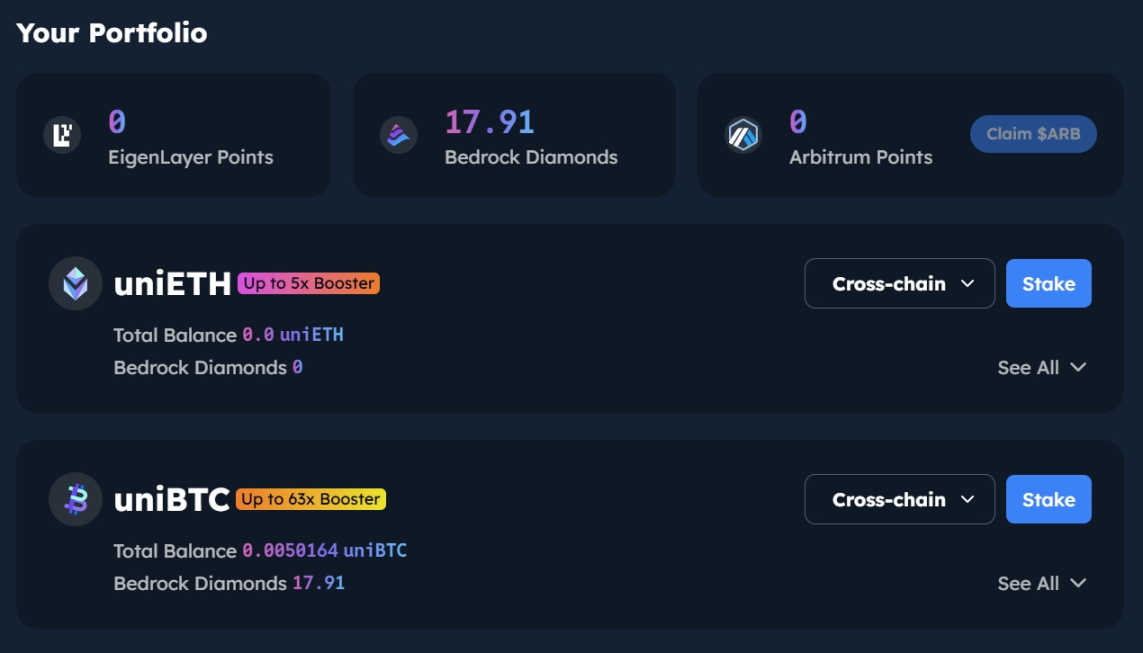
Source: https://www.bedrock.technology/
• From August 1st to August 7th, 2024, Bedrock launched a staking event in collaboration with Binance. Starting from August 1st, users holding uniBTC in their wallets will receive 21 times the Bedrock Diamond rewards per token every hour, with an additional 3x boost for Binance Web3 wallet users.

Source: https://docs.bedrock.technology/bedrock-lrt/bedrock-diamonds
5. Decentralized Custody
• Recently, the entity behind wBTC, BitGO, announced the transfer of wBTC control, sparking discussions about the security of WBTC.
WBTC
• WBTC is the earliest and most widely used form of wrapped Bitcoin, bridging Bitcoin assets to the Ethereum ecosystem and unlocking Bitcoin liquidity in the DeFi scene. However, the centralized management of this ERC-20 token form of wrapped Bitcoin has raised concerns about asset security and transparency. MakerDAO voted to stop new lending for WBTC, leading to the destruction of over $30 million worth of WBTC within a week. Interest in competing products like tBTC and Coinbase's new product cbBTC has increased.
tBTC
• When crossing from BTC to ETH, consider minting tBTC. Exchange WBTC for tBTC and either securely store it as native BTC or continue using tBTC as collateral in DeFi platforms. tBTC has seen significant adoption in Curve Finance and can also be minted into the crvUSD stablecoin, in addition to active trading in major stable and volatile pools.
FBTC
• FBTC is a new type of synthetic asset anchored 1:1 to BTC, supporting Omni-chain circulation of BTC. Initially, FBTC will be launched on the ETH, Mantle, and BNB chains, with plans for expansion to more networks, allowing users to earn yields in DeFi scenarios using FBTC.
• Key advantages of FBTC include:
- FBTC will use multi-party computation custody providers.
- FBTC's minting, burning, and cross-chain bridge will be managed by a TSS (Threshold Signature Scheme) network operated by the FBTC Security Committee and security companies.
- Reserves of FBTC can be queried in real-time and monitored and verified by security companies.
- Locked FBTC can be selectively used as collateral or participate in Babylon staking.
- Built by well-known entities in the blockchain ecosystem and trusted by a large number of miners and builders, with governance tokens as incentives.
dlcBTC
• dlcBTC is a non-custodial representation of Bitcoin on Ethereum, allowing Bitcoin holders to participate in DeFi protocols while retaining full ownership of their assets. It uses discreet log contracts (DLCs) to lock Bitcoin in a multi-signature UTXO, with one key held by the user and the other distributed across a decentralized network. Minted dlcBTC tokens can be used as collateral in various DeFi platforms such as Curve and AAVE.
• Unlike wBTC and other bridged assets like tBTC and BTC.B, dlcBTC locks Bitcoin on-chain and prioritizes user sovereignty by eliminating the need for intermediaries or custodians. dlcBTC is protected by the entire hashing power of the Bitcoin network, eliminating the need for users to send their Bitcoin to a third-party deposit address.
• Compared to wBTC, dlcBTC has the following advantages:
- Self-wrapping: dlcBTC is self-wrapped by depositors (dlcBTC merchants), locking BTC in DLCs. Self-wrapping ensures that DLCs can only be paid to the original depositor, preventing BTC from being stolen in a hack or seized by government action.
- Fully automated: While wBTC minting or burning during BitGo custody involves manual steps and takes 3-12 hours, dlcBTC is fully automated and can be minted or burned within 3-6 BTC block confirmations.
- Flexible fees: As DLC.Link is not a custodian, dlcBTC incurs lower expenses, providing more competitive minting and burning fees.
6. CeDeFi
Introduction
• CeDeFi combines the characteristics of centralized finance (CeFi) and decentralized finance (DeFi) in financial services. The end of DeFi Summer prompted the need for mechanism innovation to overcome the complexities of manual operations and interaction with liquidity pools, as well as to break through the algorithm limitations of underlying pools. After Ethereum's transition to PoS, Lido's success has driven an active asset management model for yield generation, allowing users to stake native ETH to earn stETH and unlock liquidity while earning interest. In this process, users transition from interacting with their own assets and liquidity pools to entrusting their assets to professional asset management institutions (centralized), which is the essence of CeDeFi.
• In the CeDeFi model, users lock Bitcoin in a third-party custodial network separate from exchanges, where the Bitcoin is mapped to tokens on the exchange at a 1:1 ratio. Users can then use these tokens for various operations on CeDeFi platforms, such as interest rate arbitrage trading between different markets. The actual Bitcoin is securely stored in a cold wallet isolated from the exchange. Only necessary fund flows occur between the custodial platform and the exchange account, ensuring the security of user assets.
• As of June 13, 2024, approximately 28% of the total ETH supply is staked (33 million out of 120 million), with around 29% of ETH staked through Lido (10 million out of 33 million). This indicates that the liquidity of trillions of dollars worth of BTC has not been unlocked, which is the emerging reason for CeDefi.
• Revenue sources for CeDefi typically include fee arbitrage, staking rewards, restaking rewards, and protocol revenue (such as expected airdrops). Fee arbitrage involves leveraging the interest rate differences between CeFi and DeFi systems to conduct interest rate arbitrage trades for profit. CeDeFi arbitrage strategies combine the security of CeFi with the flexibility of DeFi, allowing users to arbitrage through delta-neutral interest rates.
Project One: Solv Protocol
Project Overview
• Solv Protocol is a unified Bitcoin liquidity matrix designed to unify trillions of dollars of dispersed Bitcoin liquidity through SolvBTC.
• It received seed funding in 2021 and completed four rounds of financing, totaling over $11 million (including undisclosed strategic rounds from Binance Labs); the project contract has been audited by multiple well-known companies.

Operation Mechanism
• SolvBTC is a liquidity layer for Bitcoin, currently available on Ethereum, BNB Chain, Arbitrum, and Merlin Chain. As of July 16, 2024, the protocol's TVL has a total of 20,224 BTC, approximately $1.22 billion.
• By staking SolvBTC, users can receive SolvBTC Ethena (SolvBTC.ENA) or SolvBTC Babylon (SolvBTC.BBN).
○ SolvBTC Ethena uses Bitcoin as collateral to borrow stablecoins, which are then used to mint and stake Ethena's USDe. This process primarily generates revenue from financing and basis points obtained from Ethereum staking and Delta hedging derivative positions. Additionally, users can earn token incentives from both Solv and Ethena.
○ SolvBTC.BBN initially does not generate revenue but is designed to prepare for the launch of Babylon's mainnet, expected to launch at the end of July. The quota of 500 BTC for the first and second epochs has already been claimed.
• Solv Protocol's partnered digital asset custody institutions include Copper, Ceffu, Cobo, and Fireblocks. These custody institutions provide over-the-counter settlement solutions, allowing Solv to entrust assets to centralized exchanges or withdraw assets from centralized exchanges without transferring the actual assets.
• Technical framework: The Solv technical architecture revolves around the Liquidity Validation Network (LVN), a framework designed to provide secure liquidity validation for digital assets, focusing primarily on LST. The first asset supported by LVN is SolvBTC. Solv Guard has been launched as the foundational security module of LVN, ensuring the integrity and security of all operations within the network by supervising and managing the permissions of asset managers.
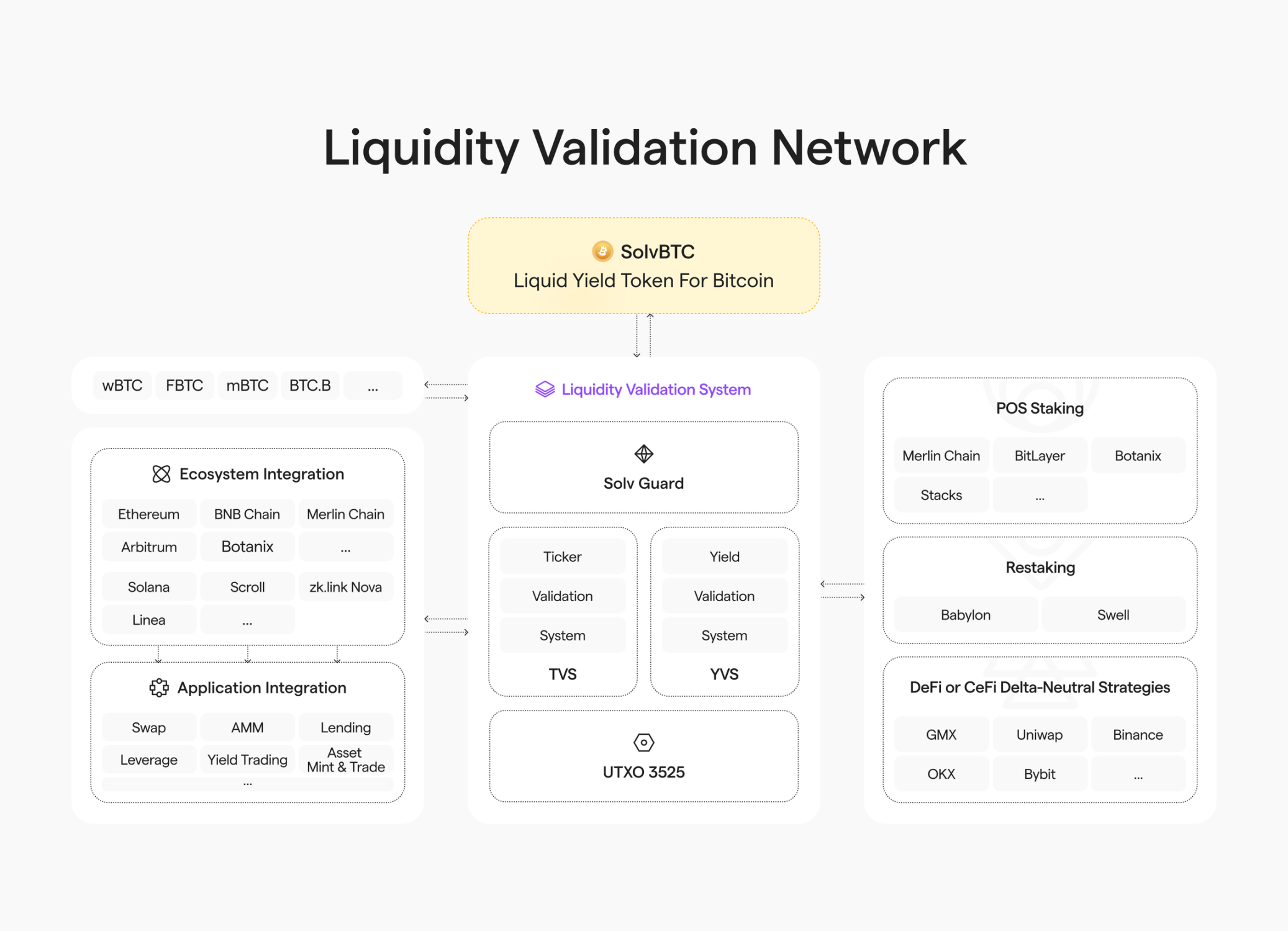
Source: https://docs.solv.finance/solv-documentation/getting-started-2/liquidity-validation-network
Project Progress & Participation Opportunities
• The Solv point system is operational and will serve as a reference for future airdrops.
○ Total XP = Base XP + Boost XP + Referral XP
○ Base XP can be increased through staking (Base XP = (XP earned per dollar deposited) x (holding time)). Additionally, users can achieve a multiplier for Boost XP by reaching a certain threshold or participating in community activities.
• Community news on July 16th announced the upcoming launch of the third epoch for SolvBTC.BBN.
Project Two: Bouncebit
Project Overview
• Bouncebit is a BTC Restaking chain that is fully compatible with EVM and features CeDeFi product design, utilizing Liquidity Custody Tokens (LCT) for restaking and on-chain farming.
• On February 29, 2024, BounceBit announced the completion of a $6 million seed round of financing, led by Blockchain Capital and Breyer Capital, with participation from CMS Holdings, Bankless Ventures, NGC Ventures, Matrixport Ventures, DeFiance Capital, OKX Ventures, and HTX Ventures. On the same day, OKX Ventures and HTX Ventures announced strategic investments in BounceBit. On April 11, Binance Labs announced an investment in BounceBit.
Operation Mechanism
• Bouncebit introduces Mainnet Digital and Ceffu's MirrorX technology to ensure regulated custody and map assets to exchanges, allowing BTC to earn interest in MPC wallets. The chain uses a BTC + BounceBit hybrid PoS mechanism for validation.
• BounceBit supports the seamless conversion of pure BTC into more flexible forms, such as BTCB on the BNB chain and Wrapped Bitcoin (WBTC). Users can choose to deposit their BTC into secure custody services accessible through the EVM network, bridging these assets to the BounceBit platform. This process allows for the accumulation of on-chain rewards without direct interaction with the Bitcoin main chain.
• The Bouncebit CeDeFi ecosystem offers users three types of revenue: original CeFi revenue (arbitrage), node operation rewards for staking BTC on the BounceBit chain, and opportunities for participation in on-chain applications and Bounce Launchpad (on-chain ecosystem DeFi revenue).
○ User contributions to TVL are managed securely by Mainnet Digital's regulated custody services to ensure compliance and security. These assets are then mirrored through Ceffu's MirrorX service, resulting in BBTC/BBUSD for users.
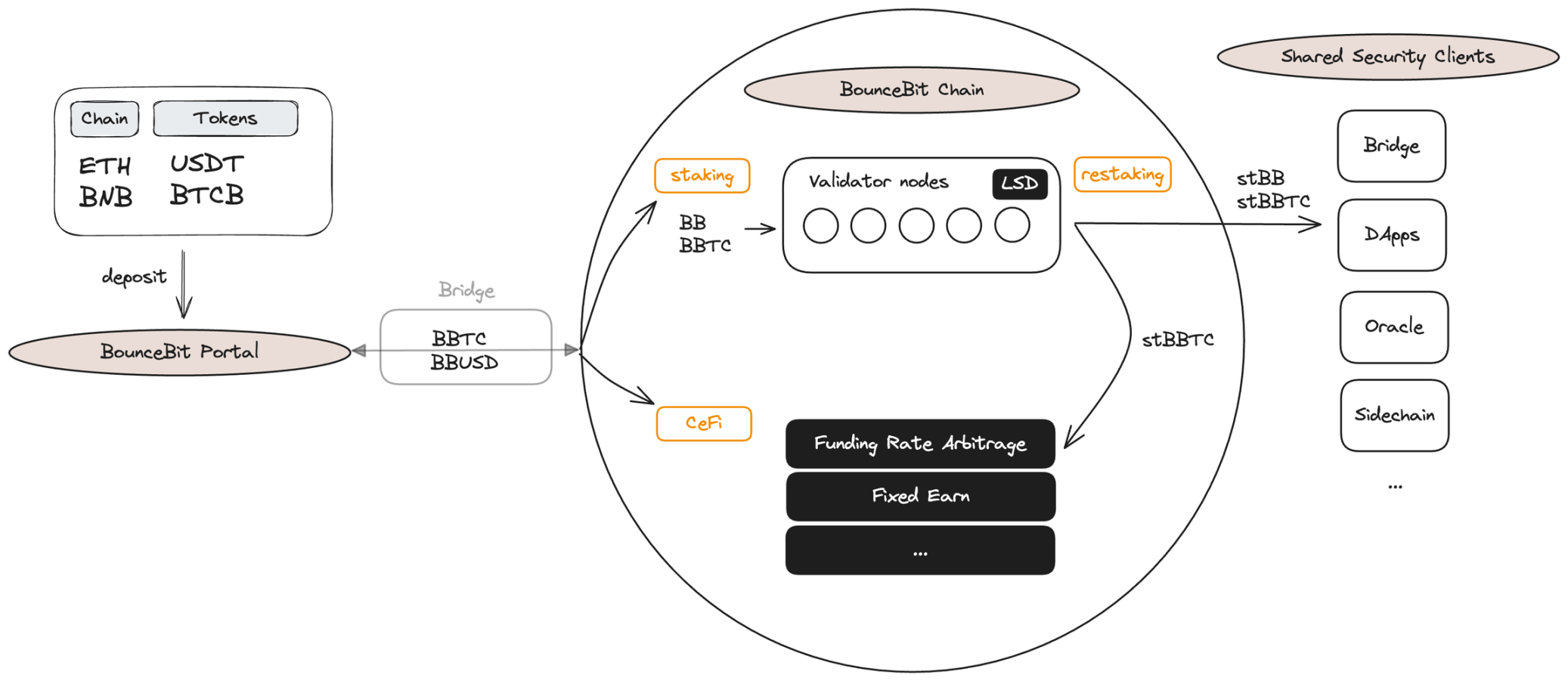
Source: https://docs.bouncebit.io/cedefi/bouncebit-cefi-+-defi/infrastructure
Project Progress
• The mainnet was launched in May, and as of July 16, the market value of $BB is $201 million, FDV is $968 million, and the mainnet TVL is $310 million.
Project Three: Lorenzo protocol
Project Overview
• Lorenzo is a BTC liquidity financial layer based on Babylon.
• On May 21, the BTC liquidity financial layer project Lorenzo announced an ecological strategic cooperation with the Bitcoin Layer 2 project Bitlayer. Lorenzo will launch a beta version on Bitlayer to accept BTC staking, supporting users to use staked liquidity collateral tokens stBTC on Bitlayer to earn additional income.
Operation Mechanism
• Lorenzo tokenizes staked BTC into Liquidity Principal Tokens (LPT) and Yield Accumulation Tokens (YAT) for each staking transaction. Lorenzo also provides infrastructure for exchanging LPT and YAT and cashing out staking rewards.
• Lorenzo matches users staking BTC with Babylon and converts the staked BTC into BTC liquidity collateral tokens, releasing liquidity to downstream DeFi ecosystems. Architecturally, Lorenzo consists of a Cosmos application chain built using Cosmos Ethermint, a relay system synchronizing BTC L1 and Lorenzo application chains, and a system responsible for issuing and settling BTC liquidity collateral tokens.
• As of July 16, 2024, the TVL is $70 million.
7. DEX AMM Swap
Introduction
• DEX AMM Swap (Decentralized Exchange Automated Market Maker Swap) is a decentralized trading mechanism that operates on the blockchain. It uses algorithms and liquidity pools to automatically provide liquidity for trading pairs without the need for a centralized order book. Users can directly exchange tokens on-chain, enjoying a low slippage, low-cost trading experience. The AMM model greatly enhances the liquidity and availability of DEX and is an important infrastructure for the DeFi ecosystem.
• The development of DEX in the Bitcoin ecosystem lags behind other chains that support smart contracts, mainly due to the original design and technical limitations of the Bitcoin network.
• Technically, AMM (Automated Market Maker), PSBT (Partially Signed Bitcoin Transaction), and atomic swaps collectively provide the technical foundation for DEX on Bitcoin. AMM manages liquidity pools through algorithms to achieve automatic pricing and trade execution; PSBT allows for the step-by-step construction and multi-party participation of complex transactions, enhancing flexibility and security; and atomic swaps enable trustless exchange of cross-chain assets, with the core mechanism being Hash Time-Locked Contracts (HTLC).
Project One: Bitflow
Project Overview
• Bitflow focuses on sustainable BTC yield, utilizing PSBT, atomic swaps, AMM, and Layer-2 solutions such as Stacks for BTC and stablecoin transactions.
• Bitflow announced the completion of a $1.3 million pre-seed round of financing on January 25, 2024, with Portal Ventures leading the investment and participation from Bitcoin Frontier Fund, Bitcoin Startup Lab, Big Brain Holdings, Newman Capital, Genblock Capital, Tykhe Block Ventures, and others. Co-founder Dylan Floyd, a former software engineer at AT&T and a graduate of Georgia Institute of Technology, serves as the CEO. Co-founder Diego Mey, a founding partner of Bussola Marketing Group, previously worked in business development at Wicked Studios.
Operation Mechanism
• Bitflow is positioned as a DEX (Decentralized Exchange) built on Stacks. According to DefiLlama data, Bitflow's current TVL is $18.27 million. The project's feature is earning native BTC yield without introducing custody risk. Users can provide liquidity in the pool to earn yield, primarily including stablecoins such as USDA, STX, stSTX, and BTC (supported after the Nakamoto upgrade on Stacks).
• Another goal of Bitflow is to build BTCFi. With BitFlow's StableSwap, xBTC, sBTC (both Wrapped BTC on Stacks), and native Bitcoin assets can easily integrate into the BitFlow ecosystem. sBTC is pegged 1:1 to Bitcoin on Stacks and operates in a fully decentralized framework supervised by an open member signatory group. xBTC is a wrapped version of Bitcoin issued on Stacks, backed 1:1 by reserved Bitcoin, similar to Wrapped Bitcoin on the Ethereum network.
Project Progress & Participation Opportunities
• Bitflow has already launched the AMM DEX mainnet, currently supporting multi-hop transactions. Additionally, the RUNES AMM for Bitflow is under construction, and interested individuals can sign up on the official website. As for tokens, $BFF is set to be released soon, and ongoing updates can be followed.
Project Two: Dotswap
Project Overview
• Dotswap is a native AMM DEX on the BTC mainnet, supporting assets including Runes, BRC 20, ARC 20, and the latest CAT 20. The mainnet was launched in September 2023 and has been updated to version 3. As of September 25, 2024, the total trading volume has reached 1770 BTC, and the current TVL is close to 60 BTC.
Operation Mechanism
• Upgraded Multisig: DotSwap's liquidity pool is supported by MMM (Multilayered Multisig Matrix), an upgraded multisig framework that integrates the advantages of MPC and native BTC multisig.
• Non-custodial permissionless atomic swaps: Utilizing PSBT technology.
Project Progress
• In Q3 2024, DotSwap introduced new tools: Rune Forging Machine and a versatile BTC transaction accelerator. The accelerator, formerly known as BTC-Speed, optimizes BTC transaction times using the Child Pays for Parent (CPFP) method. Rune forging/etching is focused on zero fees and offers three different forging modes.
Project Three: Unisat AMM Swap
Project Overview
• Unisat is a wallet application focused on Ordinals and BRC-20, facilitating trading in the runic market (including Ordinals, BRC-20, and Runes) based on an order book, which differs from typical AMM-based DEX.
• In February 2024, Unisat completed a strategic financing round and later secured a Pre-A round led by Binance in May.
• At the end of May, Unisat began airdropping pizza runes. On September 9, the Fractal mainnet developed by the Unisat team was officially launched, solidifying its dominant position in the runic field.
Comparison of Different Asset Categories
Security Comparison
• The BTC ecosystem places a much higher emphasis on "security" compared to other ecosystems, driven by the nature of BTC participants. From storing funds in wallets to specific steps in participating in DeFi solutions, security safeguards are needed, with effective control of "asset ownership" being a key focus.
• Ethereum is the largest proof-of-stake (PoS) blockchain by total staked value. As of August 2024, ETH holders have staked over $111 billion worth of ETH, accounting for 28% of the total ETH supply. The staked ETH amount is also referred to as Ethereum's security budget, as stakers are penalized by the network for protocol violations. While ETHFi has fostered a massive Ethereum ecosystem, it has also added systemic risks to the entire Ethereum network (including risks of over-centralization and runs). Since the security of PoS is determined by the value of staked coins, a decrease in security can occur if there are runs or validator dropouts. Additionally, in a bear market, a decrease in gas fees due to falling coin prices may lead to inflation in ETH, further contributing to ETH's decline. Finally, the "51% attack" is also a security issue for ETH, where validators controlling over 50% of governance rights can easily manipulate and attack the network.
• The total TVL in the Solana ecosystem reached $4.86 billion on July 17, 2024. Although it lags behind the $59 billion Ethereum ecosystem, it currently slightly surpasses BSC and ranks third after Tron. Solana also belongs to the PoS blockchain, and its security logic is similar to that of Solana. It is worth noting that Solana has more external factors and is relatively more prone to price fluctuations compared to Ethereum. For example, in April of this year, Solana experienced network congestion caused by memecoin and Ore mining.
• Given that BTC operates on a POW system, in principle, such issues do not exist. However, if excessive risks accumulate in the FI protocols, it could lead to systemic risks and potentially cause a significant drop in BTC prices, impacting the overall market trend. This would be highly unfavorable for BTCFi, especially in its early development stage, as it could easily face setbacks and require more time to gain recognition.
Yield Comparison
• There are various sources of yield that cater to different product application scenarios. Typically, these include staking yield, DeFi product yield, and protocol yield.
○ Staking yield, such as the staking yield generated by using BTC as security for the POS chain in Babylon.
○ DeFi product yield, such as arbitrage yield in Solv products or yield generated by lending protocols.
○ Protocol yield, referring to the yield generated by the protocol's token price or the expectation of token issuance.
• Below is a comparison of the yield rates and sources of ETHfi, SOLfi, and BTCfi's major projects/protocols.
○ Current yield rates and sources of popular protocols in ETHfi:
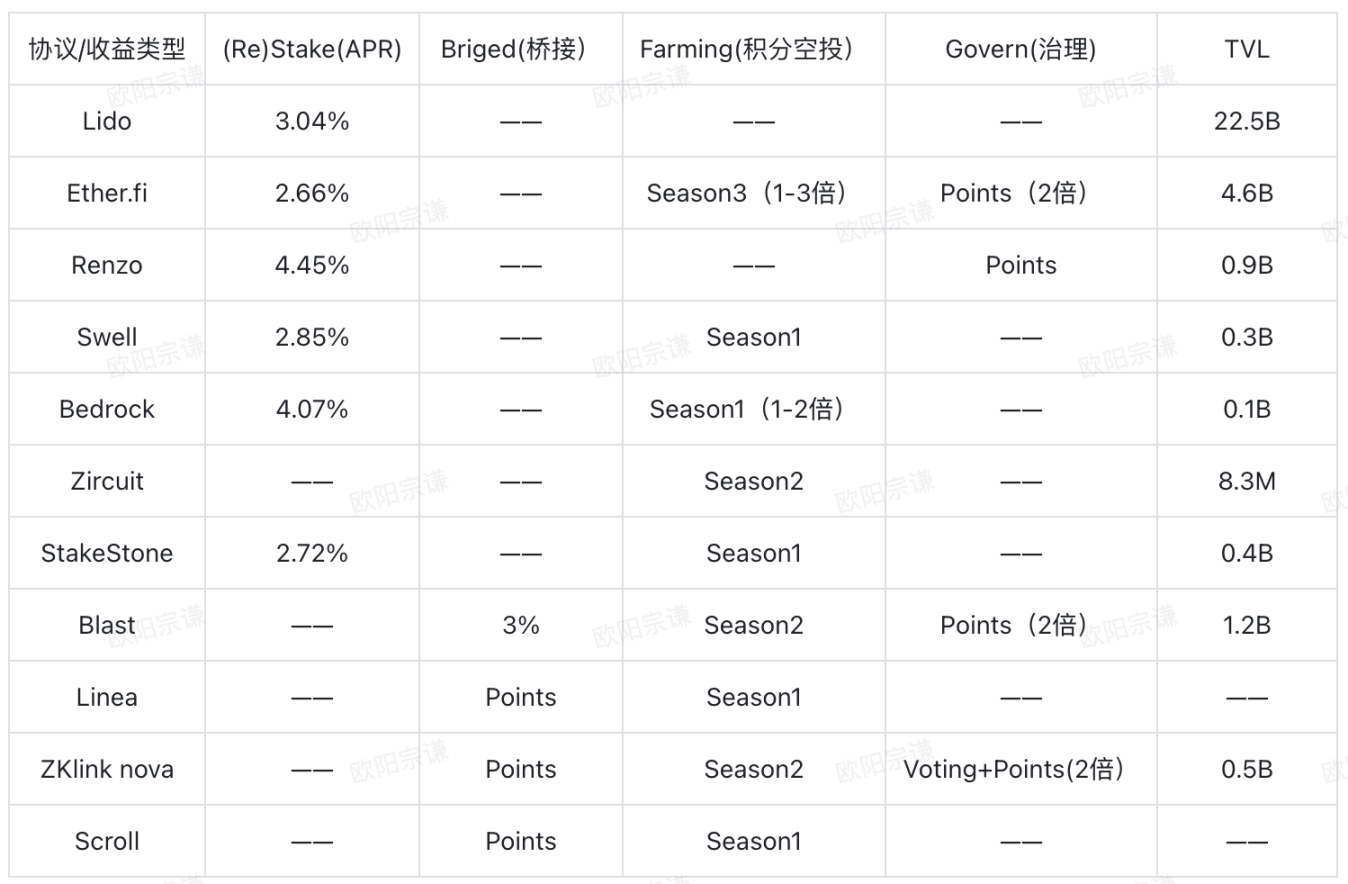
○ Current yield rates and sources of popular protocols in SOLfi:
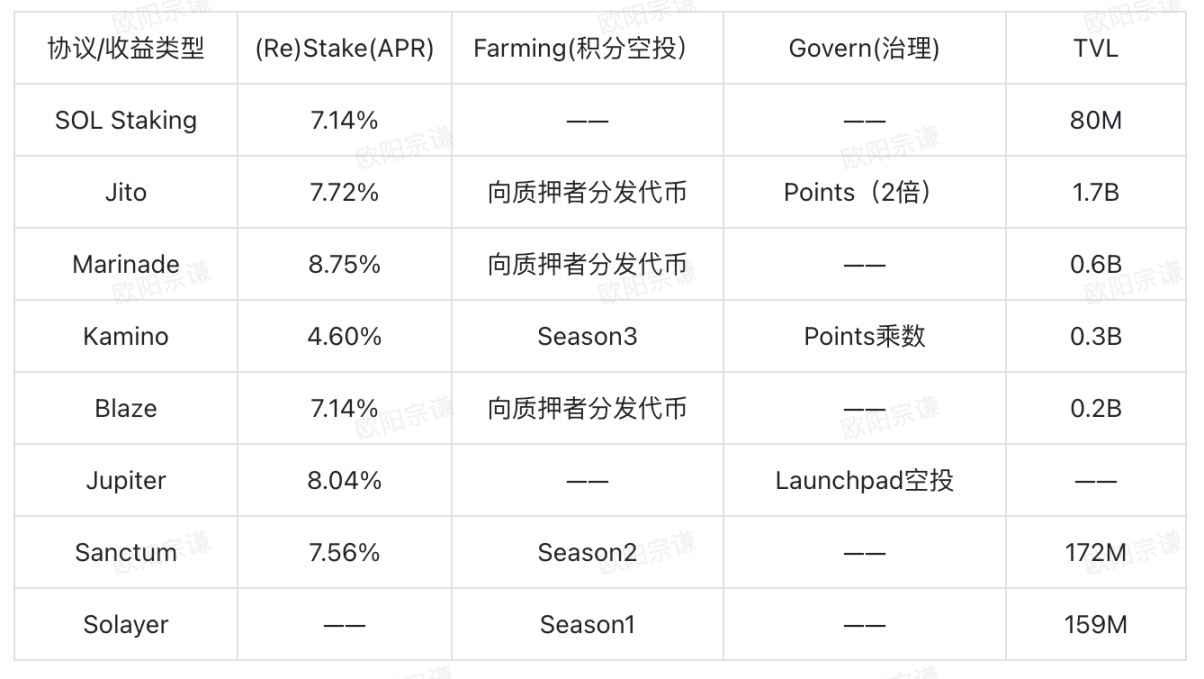
○ Current yield rates and sources of popular protocols in BTCfi:

Note: In the tables, "RETRO" indicates that the APR for Babylon has not been calculated, and the APR for other projects depends on Babylon, so it is not estimated here. Additionally, Binance, OKX, HTX, and others have conducted a series of pre-staking, farming, and other activities in collaboration with Babylon, Chakra, Bedrock, B², Solv Protocol, etc., resulting in high returns for users, especially through the Binance web3 wallet's staking activities.
• From a macro perspective, BTCFi has greater potential compared to ETHFi and SolFi because the latter two have already passed the first stage of explosive TVL growth, while BTCFi is still a blue ocean. From this perspective, BTCFi's products have higher yield rate expectations.
Ecosystem Richness
• The Ethereum ecosystem includes DeFi, NFT, RWA, and Restake. Traditional top projects such as Uniswap, AAVE, Link, ENS, and other protocols have seen further improvements in real user growth and effective usage frequency. Since 2023, many Ethereum liquidity staking/re-staking protocols such as Lido, EigenLayer, and others have attracted significant funds.
• On Solana, DEX Raydium and liquidity solution Kamino Finance have a total TVL close to $1 billion, making them two leading projects in the Solana DeFi ecosystem. In terms of TVL, Jupiter, Drift, Marginfi, and Solend follow closely. Solana also operates as a PoS blockchain, with most funds concentrated in Liquid Staking, with Jito being the leading project.
• For BTCFi, the asset categories and TVL on Fi need to be considered. According to CryptoCompare and CoinGecko data, the BTCFi market size reached approximately $10 billion in 2023. This data includes the total locked value (TVL) of BTC in the decentralized finance (DeFi) ecosystem and the market size of financial products and services related to BTC. The increasing number of BTC holders implies the influx of new user groups and funds. The approval of ETFs has also propelled BTC into a super bull market, with the number of new wallets containing BTC gradually increasing.
• In addition to BTC itself, there is a rich variety of assets participating in BTCFi. These include first-layer assets based on the BTC network such as runes and symbols; second-layer assets based on the BTC network such as rgb++, taproot assets; wrap/stake assets on the ETH chain such as WBTC, various LST or LRT certificates representing staked BTC; these assets expand the liquidity of Fi, enriching the future Fi scenarios.
• In terms of protocols and ecosystem projects, the Bitcoin ecosystem is experiencing a period of explosive growth, with numerous projects emerging, including Layer 2, and increasing VC financing, attracting market attention. Examples include merlin, Bouncebit around BTC's second-layer network; lending protocols like BlockFi, Celsius Network; stablecoin protocols like Satoshi Protocol, BitSmiley; staking protocols like Babylon, Pstake; and restaking protocols like Chakra, Bedrock.
Conclusion
In this rapidly evolving digital age, as global institutions and tech giants enter the scene, the number and complexity of public chains continue to increase. However, Bitcoin (BTC) has maintained its unique position. 1 BTC will always equal 1 BTC, and its value has stood the test of time, proving its potential as a long-term appreciating asset. BTC is not just a string of numbers or code; it is an asset with high liquidity and utility, demonstrating its unique value in simplifying cross-border transactions, supporting electronic payments, and having widespread applications in the financial sector.
The demand for BTC liquidity from investors is growing, and developers are actively exploring the programmability of Bitcoin to unleash its full potential. BTCFi has emerged in this context, not only meeting the market's desire for BTC liquidity but also further driving the activity of the BTC network by increasing the use cases for Bitcoin. As the BTCFi ecosystem continues to develop, we witness healthy competition between protocols, which not only reduces centralization risks but also promotes the maturity and diversification of the entire BTC ecosystem.
Looking ahead, BTCFi will continue to serve as an innovative engine in the crypto finance field, propelling the Bitcoin network towards higher-level financial applications and global participation. With ongoing technological advancements and market expansion, BTCFi is poised to become a bridge connecting traditional finance and the cryptocurrency world, providing users worldwide with richer, more secure, and efficient financial services.
免责声明:本文章仅代表作者个人观点,不代表本平台的立场和观点。本文章仅供信息分享,不构成对任何人的任何投资建议。用户与作者之间的任何争议,与本平台无关。如网页中刊载的文章或图片涉及侵权,请提供相关的权利证明和身份证明发送邮件到support@aicoin.com,本平台相关工作人员将会进行核查。




